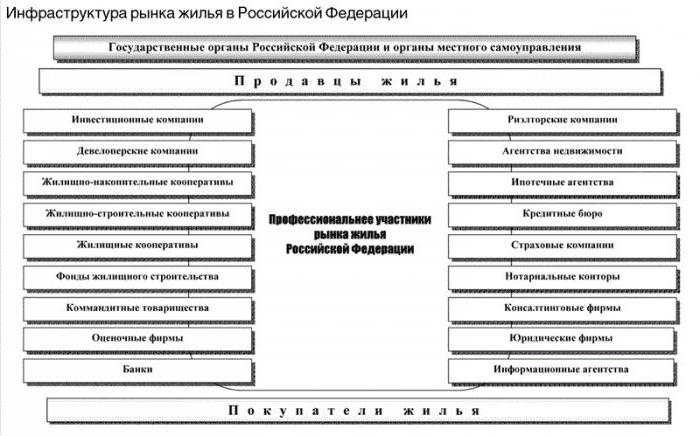Housing law does not define the concept of housing relations. The concept, structure and types of housing relations is a rather complicated topic. Until the Housing Code of the RSFSR was adopted, this concept usually refers to civil law relations arising in relation to the use of residential premises. These relations were regulated by civil law. After the adoption of the LCD, the term "housing relations" began to be used in a broader sense.
Consider the types of housing relations, as they are.
What is a housing relationship?
Housing legal relations arise when solving issues of ownership, as well as use, change and termination of rights to use, disposal of premises for residential purposes, which are in state, municipal or private disposal. This also includes issues of redevelopment of residential premises, the activities of housing cooperatives and partnerships, as well as payment for utilities and the maintenance of the housing stock.
In other words, they are relationships that arise regarding the ownership, use, disposal and management of housing.
Housing Relationship Structure
We will reveal the concept and types of housing relations.
The structure of any legal relationship is a combination of three elements. This is the subject, object and content of legal relations. The subjects in this case include persons, including legal entities, participating in housing legal relations. In addition, it can be citizens of foreign states, foreign legal entities and stateless persons. The main subjects of these legal relations are the owners or tenants of residential premises. Moreover, only citizens are entitled to be employers. When a legal entity enters into a lease for a premises, it is a party to the lease under the agreement, but does not have housing rights. A legal entity has the right to use the housing stock only for the purpose of residence of citizens. The object of housing legal relations is always a dwelling.
The content of legal relations
As for the issue of the content of these legal relations, its multidimensionality does not allow us to consider it in this article in full. We will only say that the legal content of housing legal relations refers to the rights and obligations that are associated with the subjects of these legal relations. In addition to the legal content of legal relations distinguish between material and ideological. Material content is a social relation that underlies the legal relationship and is fixed with its help. Ideological content implies the will of the state, as a necessary screw for the link between material and legal content.
Types of housing relations
Issues related to housing legal relations are diverse, but legal scholars managed to divide them into two groups.
The first group includes organizational legal relations developing on a power basis with government officials. The second group included property legal relations, which are formed on an equal footing between their participants. This also includes the relationship between entities in matters of use and ownership of the housing stock. Such relationships may be based on a social or commercial tenancy agreement.
In addition, the same group also includes participants in rental agreements for specialized premises, as well as rental agreements for residential premises. In this case, this is just an example, there are other types of relationships between participants in housing relations. The owner of the housing stock may be a legal entity, the state, federal subjects, municipalities. In this case, the owner manages the housing stock through the management bodies of the housing and communal services. The relations that arise in the management of housing stock do not relate to organizational relations; rather, these are purely managerial issues. The exact opposite is the situation between housing maintenance companies and housing users. As a rule, this is a relationship arising from a contract of employment.
The concept and types of housing relations are of interest to many.
With the formation of the residential market, almost all residential premises are involved in it (the exception is the premises for social use, which are transferred to the needy at no cost). Market relations usually arise on the basis of a contract for the commercial rental of housing, a lease agreement and other agreements concluded in most cases on a paid basis, and are regulated by civil law.
Other housing relationships
The Housing Code governs the relationships that arise in connection with:
- The emergence, implementation, amendment, termination of ownership, use and disposal of housing owned by the state and municipalities.
- Using residential premises owned by private owners.
- Using the common property of the owners of the premises.
- Recognition of residential premises and their exclusion from the housing stock.
- Housing accounting.
- Maintenance and repair of housing.
- Reconstruction and redevelopment of residential premises.
- Housing management.
- The provision of utilities.
- Payment for housing and utilities.
These types of housing relations are quite common.
Housing Relationships
This list of possible housing legal relationships is enshrined by the legislator. The above species are divided into subspecies, for example, in this situation there may be primary and derivative legal relations. Those legal relations that arise in connection with the use and possession of residential premises by the owners themselves are the primary legal relations, and if they arise with the tenant, they will be considered derivatives.
Among the above-mentioned legal relations, it is necessary to say more about the relations that arise in connection with the management of residential multi-apartment buildings. All housing relations, including repair, redevelopment, reconstruction of residential premises, as well as the operation of utilities can be regulated by civil law, but taking into account the norms of the housing code.
Features of housing relations
What is the difference between the types of housing relations (the scheme is presented below)?

- The object of such legal relations is always a dwelling.
- Housing legal relations are structurally complex, since each of the entities is entitled to claim another participant and at the same time has the obligation to act in accordance with the powers of the second entity.
The prerequisites that are basic for the emergence of housing legal relations are specific life circumstances with which legal norms relate various changes in the status of subjects of housing legal relations.
The Housing Code says that relations of this type arise from the grounds provided for by housing legislation, federal laws and other legal acts.In addition, such grounds are the actions of subjects of housing relations, which, if not provided for by such acts, then, based on the meaning and general principles of the law, give rise to rights and obligations.
Legal basis
Once again, we note that the fundamental types of contracts governing housing relations can be:
- Contracts provided for by federal law or not contradicting it.
- Acts of state authorities, municipalities, etc., prescribed by law.
- Decisions of the judiciary determining the occurrence or termination of housing rights and obligations.
- Registration of membership in various housing cooperatives and partnerships.
- Certain events with which the legislation of the Russian Federation connects the emergence of rights and obligations in housing legal relations.
We considered housing legal relations, the concept, features and types.